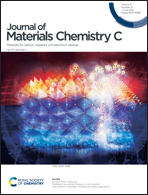Manipulation of the size of polystyrene spheres as the templates for internal light out-coupling structures of a white organic light-emitting diode†
Abstract
Trapped light in an organic light-emitting diode (OLED) can be extracted through the construction of periodic structures on the substrates. However, these periodic structures can merely enhance the light emission of a specific wavelength, but not the white light for lighting application. In this work, indium tin oxide (ITO) with a corrugated structure is prepared by reactive ion etching of a polystyrene (PS) sphere matrix with diameters of 300 and 350 nm, which can apparently reduce the losses produced by the waveguide mode and surface plasmon polariton (SPP) mode in the RGB-based white OLED. The extractions of the waveguide mode and SPP mode are investigated theoretically and experimentally. This special corrugated ITO structure with the pitches of 300 and 350 nm, as an internal light out-coupling structure, is useful for the extraction of bluish green and red emission, respectively. More importantly, there are significant enhancements in both the current and power efficiencies of white OLEDs, and the CIE coordinates are located in the warm white region with different viewing angles. Using different weight ratios of the mixed PS spheres, the electroluminescent spectra of white OLEDs can be easily adjusted.



 Please wait while we load your content...
Please wait while we load your content...